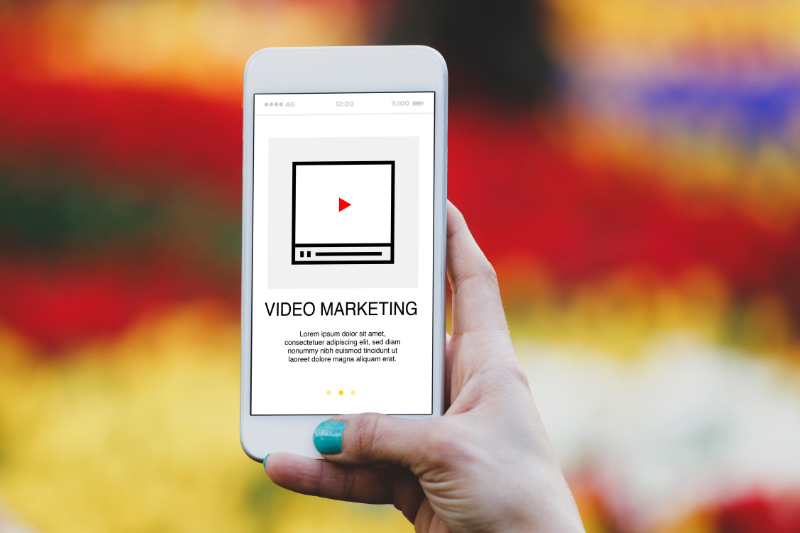With research showing that 72% of consumers prefer learning about a product through video, the importance of incorporating a video marketing strategy cannot be overstated. As we look ahead to 2025, more consumers will seek out visually compelling content, making video marketing essential for businesses looking to stay relevant.
Benefits of Video Marketing for Businesses
Why should your business embrace video marketing? Here are the key benefits:
- Increased Engagement: Videos capture attention faster than text or images. Platforms like TikTok and Instagram Reels thrive on short-form content that can go viral in a matter of minutes.
- Higher Conversion Rates: Including videos on landing pages can increase conversions by up to 80%. Videos simplify decision-making by visually demonstrating a product’s benefits.
- Improved SEO: Embedding videos on your website increases user engagement, signalling search engines that your content is valuable.
- Humanises Brands: Videos add a personal touch, whether through behind-the-scenes glimpses or heartfelt customer testimonials, helping your brand become more relatable.
- Impressive ROI: Companies using video content report 49% faster revenue growth than those that don’t.

Developing an Effective Video Marketing Strategy
To make the most of video content marketing, having a solid strategy is crucial. Here’s how to build one:
- Define Your Objectives: Ensure your video strategy aligns with your business goals. Whether you’re aiming for brand awareness, lead generation, or customer engagement, set measurable objectives.
- Understand Your Audience: Identify your target audience’s preferences, pain points, and behaviours. This will help you create videos that resonate with them.
- Set a Budget: Don’t worry if you’re working on a tight budget. With modern smartphones and free editing tools, high-quality videos are more accessible than ever.
- Choose Distribution Channels: Decide which platforms best suit your audience—YouTube, TikTok, Instagram, Facebook, or LinkedIn.
- Create a Content Calendar: Consistency is key. Plan your video releases around relevant dates such as product launches, seasonal promotions, or industry events.
Tailoring Your Video Marketing Strategy for 2025
Generic approaches to video marketing no longer cut it in today’s competitive environment. To stand out, adopt a highly tailored strategy:
Audience-Centric Approach
Your audience should be at the core of your strategy. Use analytics tools like Google and YouTube Analytics to build detailed customer personas, including both demographics and psychographics.
- Millennials and Gen Z: Lean towards short-form content on TikTok and Instagram Reels.
- Professional Audiences: Consider long-form content on LinkedIn or YouTube.
Platform-Specific Strategy
Each platform has its strengths:
- YouTube: Great for tutorials, product reviews, and educational content.
- Instagram & TikTok: Best for visually appealing, short-form content.
- LinkedIn: Ideal for professional or B2B content.
- Facebook: A mix of live videos, community discussions, and behind-the-scenes content.

Creating Engaging Video Content That Resonates
Creating videos isn’t enough—they need to capture attention and hold it.
Storytelling for Impact
Good storytelling is at the heart of impactful videos. Use emotional narratives to connect with your audience, just like Nike’s “Just Do It” campaign. Show how your product or service solves a problem or enhances lives.
Short and Snappy Intros
The first 5–10 seconds are critical. Use eye-catching visuals and text overlays to hook viewers, especially on platforms where videos autoplay without sound.
Visual and Auditory Appeal
High-quality visuals and sound are essential for professional videos. If you’re on a budget, invest in good lighting and a microphone. Websites like Epidemic Sound offer royalty-free music to enhance your video’s mood.
Short-Form vs. Long-Form Videos: Which is Best?
The optimal video length depends on your goals and platform.
Short-Form Videos
- Under 60 seconds.
- Ideal for Instagram Reels, TikTok, and YouTube Shorts.
- Higher engagement rates: Research shows short videos retain viewers better, with retention rates of up to 50% for videos under 90 seconds.
Long-Form Videos
- Best for YouTube and LinkedIn.
- 2–10 minutes or more.
- Allows for in-depth storytelling, tutorials, and case studies, helping build trust and showcase expertise.

Leveraging the Power of Live Video
Live video offers real-time interaction and authenticity. According to Statista, the live streaming market is projected to hit $184 billion by 2027. Consider these ideas:
- Product Demos or Launches: Showcase new products live and engage with viewers through Q&A.
- Behind-the-Scenes Content: Give your audience an exclusive look into your business operations.
- Live Q&A Sessions: Address audience questions in real-time to build engagement.
Top live platforms include:
- Facebook Live
- YouTube Live
- Instagram Live

The Future of Video: AR, VR, and Interactive Videos
As video technology advances, AR, VR, and interactive videos will dominate the landscape:
- Augmented Reality (AR): Integrate digital elements into the real world, allowing customers to “try on” products or explore spaces virtually.
- Virtual Reality (VR): Immerse viewers in a complete virtual environment, useful in industries like real estate or retail.
- Interactive Videos: Let viewers click or make choices during the video for a more personalized experience. Interactive videos allow viewers to click, drag, or make choices within the video itself. This provides a personalized experience, increasing engagement and retention. For example, platforms like Wirewax and Eko offer tools to create interactive videos where users can make decisions, take quizzes, or explore additional information.
These technologies may seem out of reach now but are becoming more accessible for small businesses, offering a competitive edge for early adopters.
Unexplored Markets: Niches to Target in 2025
Exploring new, underrepresented markets is one way to gain a competitive advantage. Here’s how to identify and tap into these untapped niches:
Finding Niche Audiences
Use tools like Google Trends, BuzzSumo, or SEMrush to identify emerging interests or underserved audiences. Focus on industries or customer segments that larger brands may overlook due to their size. For example, specialised products for eco-conscious consumers, local artisans, or minority groups can provide your business with new avenues for growth.
Platform-Specific Niches
Smaller video platforms like Twitch or Vimeo might not have the broad reach of YouTube or TikTok, but they cater to niche communities. For example, if your business serves a gaming or tech audience, Twitch can be a valuable platform for targeted video content.
By focusing on niche markets and less crowded platforms, SMBs can carve out a unique position in the video marketing space for 2025.
Maximising ROI from Your Video Marketing Efforts
To ensure your video marketing strategy yields a high ROI, consistently track performance and optimise:
- Set Clear Objectives & KPIs: Track metrics like engagement rate, watch time, click-through rate (CTR), and conversion rate to gauge success.
- A/B Test: Experiment with different video versions—varying the intro, CTA, or length—to see what drives better results.
- Utilize Analytics for Optimisation: Every platform, from YouTube to TikTok, offers detailed analytics that can help you evaluate how well your videos are performing. Dive deep into metrics like average view duration, audience retention, and drop-off rates to understand where viewers lose interest.
- Repurpose Your Video Content: To get the maximum ROI from each video, repurpose it across different platforms. A single video can be edited into shorter snippets for TikTok, Instagram Reels, or Facebook Stories, while longer versions can be posted on YouTube or used in email campaigns.
This approach allows you to extend the lifespan of your video content while reaching a wider audience without creating brand-new videos for each platform. For instance, you can take a 5-minute educational video and split it into 3-4 smaller clips to use as teasers or in a LinkedIn carousel. - Boost Videos with Paid Advertising: While organic reach is great, a well-targeted paid ad campaign can give your video the visibility it needs to generate higher ROI. Platforms like YouTube, Facebook, and Instagram allow you to target specific demographics, interests, and behaviours, ensuring that your content reaches the right audience.
For example, you can use YouTube TrueView ads, which are skippable ads that only charge you if the viewer watches the ad for at least 30 seconds. This is an excellent way to ensure that you’re only paying for engaged viewers. - Video SEO for Organic Reach: One of the often-overlooked aspects of video marketing is search engine optimization (SEO). By optimising your video content for search engines, you can increase its chances of appearing in search results, driving organic traffic.
- Use relevant keywords in your video title, description, and tags to make your video more discoverable.
- Create a transcript of your video and upload it as closed captions, as this helps both viewers and search engines understand your content better.
- Optimise your thumbnails to be visually appealing, which can significantly impact click-through rates.
- Track and Adjust Based on ROI Metrics: Your video marketing ROI isn’t just about immediate conversions. Consider long-term metrics like brand recall, customer loyalty, and lifetime value (LTV). Look at the big picture, evaluating not just one-off purchases but how your videos influence customer behaviour over time.

How SMBs Can Maximise Video Marketing ROI
Cost-Effective Tools and Resources
Small businesses often think high-quality video production requires a big budget, but that’s not necessarily true. Free or low-cost editing tools such as DaVinci Resolve, HitFilm Express, and iMovie allow you to create professional-grade videos. Canva and Lumen5 also offer easy-to-use platforms for creating polished video content quickly. By using these resources, SMBs can significantly lower production costs while still delivering high-quality videos.
Repurposing Content
Maximise ROI by repurposing existing content. For example, turn a blog post into a video tutorial or transform a customer testimonial into a shareable social media clip. This allows you to stretch your content further and reach audiences on different platforms with minimal additional effort.
Leverage User-Generated Content
User-generated content (UGC) is one of the most cost-effective ways to create authentic video content. Encourage your customers to share videos of them using your product or service. Not only does this reduce your production costs, but it also builds trust through real customer experiences.
Optimising Video for Search Engines
SEO isn’t just for text—your videos can benefit from it too. Add keyword-rich titles, descriptions, and tags to your videos to help them rank higher in search results. Platforms like YouTube allow you to optimize each video for search engines, increasing its discoverability.
Wrapping It Up: Video Marketing in 2025
As we move into 2025, video marketing continues to be one of the most powerful tools for businesses of all sizes. The combination of higher engagement, increased visibility, and improved ROI makes it a non-negotiable part of any digital marketing strategy. Whether you’re a small business owner aiming to boost local awareness or a global brand seeking to humanise your message, video content can help you achieve your goals.
The landscape will continue to evolve with trends like short-form video, AI-driven automation, and interactive content, providing exciting new ways to connect with audiences. By developing a well-thought-out video marketing strategy, analysing your performance, and staying ahead of trends, you can ensure your business thrives in 2024 and beyond.
Now that you’ve got the full guide on video marketing for 2025, it’s time to start shooting. Whether you’re creating content for TikTok or launching a new YouTube series, remember: the key is to stay authentic, be consistent, and always provide value to your audience.
By continually testing and refining your video content, you’ll ensure that your strategy remains effective, yielding better engagement and higher conversions.






